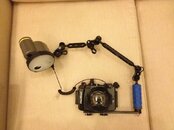You obviously have never used one. I thought the same thing as you until a friend of mine let me look through her DSLR with EVF at the safety stop. It took about 8 microseconds to adjust, and then fall in to the image projected in my eye.
Have you ever used binoculars or telescope?
Which do you think is better?
- Looking at a camera LCD attached to the Telescope
- Putting your eye to the telescope
.
Which one do you think has more details?
- The LCD on the camera is less that 460,000 pixels.
- The image on the DMW-LVF2 with 1,440,000 pixels.
.
The EVF provides a 100% field of the live image and projects it on your retina, just like the telescope or binoculars. Near or far sighted is doesn't matter; you don't have to focus and everything is perfectly sharp. It isn't large or small. Shut one eye and just like the telescope,
it fills your whole mind. The LCD is puny, dim and washed out by comparison.
I have shot thousands of photos using LCD not knowing if the details were there or not until later examining on the computer. It's not my eyesight, it's the LCD. They get washed out in bright light. The colors will turn to muted B&W when the light is intensely blue. There isn't enough contrast to see the ribs in a transparent fin. There aren't enough pixels to show the details.
Having the small space between your eye and the face plate of the mask is not perfect, but low-volume black-skirted masks like the Atomic frameless gets your eye close enough for optics on the housing to take care of the rest. It still projects on the back of your eye like binoculars or telescopes filling your whole world.
The difference is night and day.






